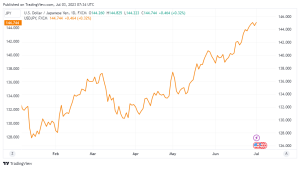The USDJPY pair begins the new week on a high note. Reversing a significant portion of Friday’s retracement drop from its highest level since November 2022. Spot prices maintain intraday gains as the European session begins, but may struggle to capitalize. On a rise over the 145.00 psychological level. Speculation that the Japanese government may interfere in the markets to support the weakening native currency may turn out to be a crucial factor. That limits any further advances for the yen. However, the negative is mitigated by a significant divergence in monetary policy stances made by the Bank of Japan (BoJ). And other major central banks, particularly the Federal Reserve (Fed).
The BoJ policy divergence continues to underpin and sustain the USDJPY.
Indeed, market investors appear to believe. That the Bank of Japan’s negative interest-rate policy would be maintained at least until next year. Furthermore, BoJ Governor Kazuo Ueda recently ruled out any adjustment in ultra-loose policy settings. And indicated no immediate intentions to alter yield curve management measures. In contrast, Fed Chair Jerome Powell stated last week that two more rate hikes are expected before the end of the year. Markets reacted quickly, pricing in a roughly 85% possibility of a 25-bps lift-off. At the FOMC meeting scheduled for July 25-26. This supports rising US Treasury bond rates, which revives US Dollar (USD) demand and should underpin the USDJPY pair for the time being.
Nonetheless, the mixed US inflation statistics released on Friday reinforced optimism that the Fed will finally moderate its aggressive approach, sooner rather than later. It is worth noting that the annual PCE Price Index fell to 3.8% in May from 4.3% the previous month, according to the US Bureau of Economic Analysis. Further data revealed that US consumer spending slowed considerably in May, and the Core PCE Price Index, excluding volatile food and energy components, fell to 4.6% in the reported month from 4.7% the previous month. The measure, on the other hand, remains considerably over the Fed’s 2% objective, supporting the probability of future policy tightening. As a result, the USD bulls’ benefit and the USDJPY pair should benefit.
Fears of intervention might limit advances ahead of this week’s crucial US announcements.
The market’s focus now shifts to crucial US macro data due at the start of a new month, beginning with the publication of the ISM Manufacturing PMI later today morning in the early North American session. The attention, though, will remain on the FOMC meeting minutes on Wednesday, which will be scrutinized for new clues regarding the direction of future rate hikes. Aside from that, the frequently anticipated US monthly employment data – often referred to as NFP on Friday – could affect the near-term USD price dynamics and define the next leg of a directional trend. The USD/JPY pair is on the move. Meanwhile, the aforementioned underlying background implies that the path of least resistance for spot prices remains to the higher.
USDJP Technical Outlook
Technically, spot prices find adequate support and halt the retracement decline from the YTD top at the 100-hour Simple Moving Average (SMA). The aforementioned support is now located around 144.30-144.20, or the Asian session low. Which should now serve as a critical milestone.
A convincing breach below may trigger some technical selling, dragging. The USDJPY pair closer to the 143.60-143.50 horizontal support zone on its way to the 143.00 round-figure barrier.
The corrective loss might continue further to the 142.65 intermediate support. But any additional dip is more likely to draw buyers. New buyers have arrived at the 142.00 resistance level.

Bulls, on the other hand, may now wait for prolonged strength and acceptance above the 145.00 level. Before positioning for additional gains against a slightly overbought Relative Strength Index (RSI) on the daily chart.
The USDJPY pair, on the other hand, is prepared to break through the 145.35-145.40 intermediate barrier. And retake the 146.00 round number. Following-through purchasing should pave the way for a rise towards the 146.25-146.30 area. On the road to the 147.00 level and the next key obstacle at the 147.45-147.50 region.









